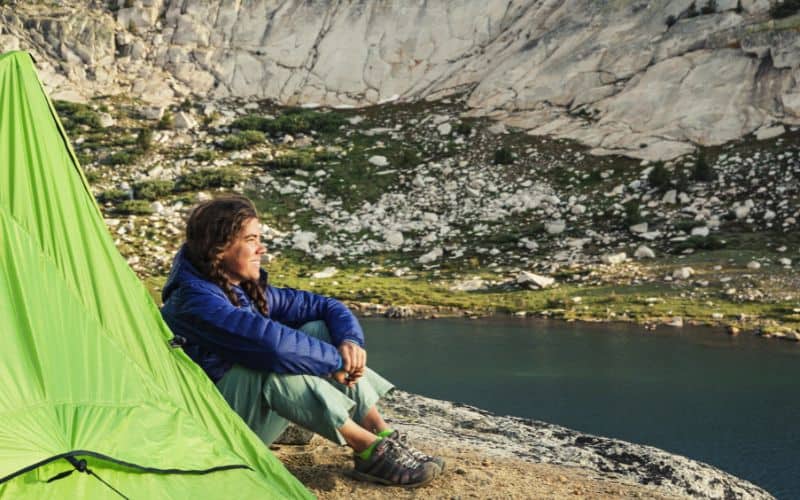You’re all packed up and ready to go on your big camping trip and then your period starts. Camping at that time of the month can be inconvenient, to say the least, but don’t let it ruin your fun!
Whether it’s a camping, hiking, or backpacking trip, menstruation shouldn’t hold you back from spending quality time in nature. Figuring out how to deal with your flow outdoors is another aspect of learning how to hike and camp as a person that menstruates.
In this guide, we’ll cover everything you need to know to camp in comfort during your period, including the best products to use, how to prepare, and what to pack.
Table of Contents
Tips For Hiking, Camping, and Backpacking on Your Period
Don’t let menstruation hold you back from enjoying time outside! These tips will help you deal with your flow while enjoying the great outdoors (without skipping your period altogether using your birth control methods).
Choosing Your Menstrual Hygiene Device or Period Products
Figuring out which products to use is a personal preference, similar to choosing hiking shoes over hiking boots. These are the menstruation management options that work best for campers, hikers, and backpackers.
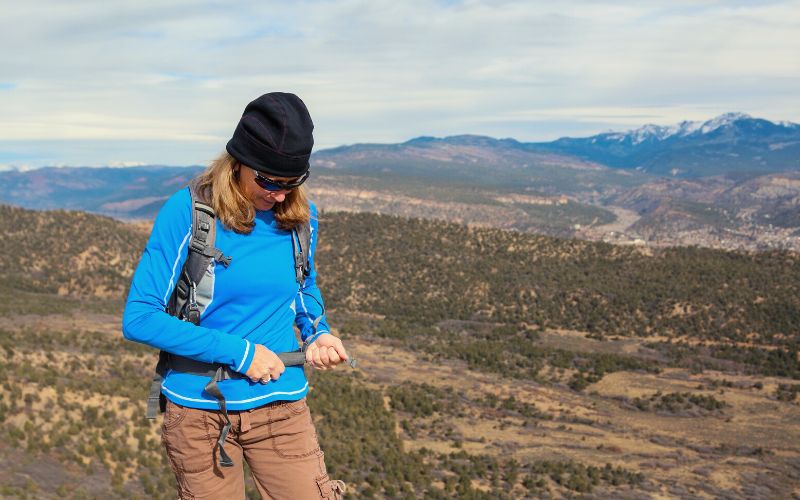
Menstrual Cup
A menstrual cup is a silicone cup that can be worn for a maximum of 12 hours at a time. It’s a reusable, waste-free option and a relatively longer-wearing solution for dealing with your period. This is a great choice for lengthier treks and multi-day trips in the backcountry.
When it’s time to empty your menstrual cup, dig a six- to eight-inch deep cat hole at least 200 feet away from your campsite, empty the contents of the cup into it, and then refill the cat hole with dirt.
There are some campgrounds in environmentally-sensitive zones that don’t allow hole digging and require you to pack out all of your waste. In these areas, you can bring a reusable water bottle to store the menstrual waste until you can dispose of it properly.
Menstrual cups need to be kept clean, especially when menstruating in nature. Rinse the menstrual cup with drinking water after each use and steep the cup in boiling water to sterilize it. Check your cup’s disinfection instructions for recommended boiling times. Always be sure to wash your hands well with soap and clean water before handling and inserting your cup.
Tampons
Tampons and other disposable products are the most commonly used method for dealing with your flow. Unfortunately, they are single-use and create more waste, but they’re convenient to use and easier to keep sterile while outdoors than a menstrual cup. Use tampons without applicators to reduce the amount of waste produced in the backcountry.
Most brands of tampons aren’t biodegradable (some tampons are!) and those that are can take up to 800 years to decompose. With that in mind, you should not dig a hole to bury a used tampon in the ground outdoors. Follow Leave No Trace principles by placing your used tampons in a bag until you can dispose of your trash properly.
Many campers that menstruate use a disposable zip-close freezer bag covered with duct tape to reinforce the bag and hide the contents. Be sure to mark the bag as trash so you don’t get it confused.
Remember that tampons should only be worn for up to eight hours at a time, no matter how light your flow is. Leaving a tampon in for longer than the recommended maximum can cause a vaginal microbiome imbalance, which can develop into a yeast infection or – worst case scenario – toxic shock syndrome.
Avoid scented tampons and pads since strong fragrances can attract wild animals.
Period-Proof Underwear
Period underwear is reusable underwear that absorbs a certain amount of menstrual blood and can be worn all day.
This period management technique works best when you camp near water sources because you need to wash them between uses and let them dry overnight. This might not be the best option if you have limited access to water during your trip or if you have a heavier flow.
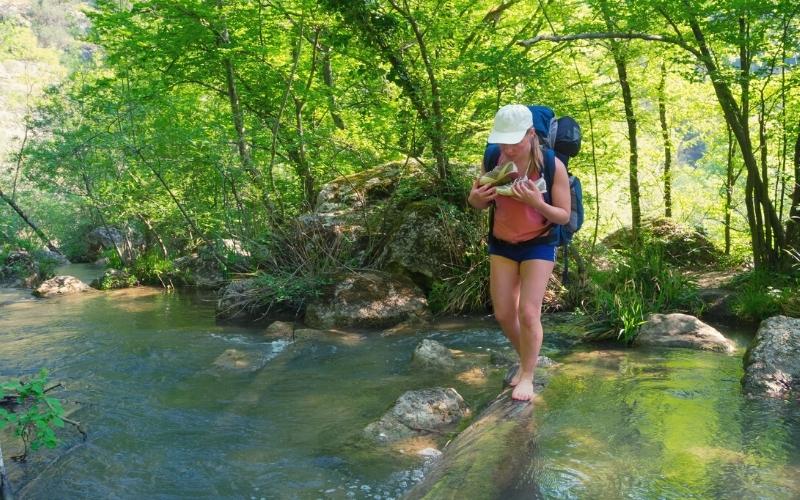
Some period-proof underwear can hold the equivalent of up to three to four tampons before they reach maximum absorbency, while some panties are only for lighter flows.
Our advice? Bring a variety of panties that align with your needs. Period underwear can be worn in addition to the menstrual products mentioned above as an additional layer of protection. Period-friendly shorts are another option for lighter flow days.
Other Things to Pack
In addition to your preferred period product, it’s important to bring along a few other things to create a period kit for heading outdoors while menstruating.
Toilet Paper
Pack a roll of toilet paper to use for bathroom breaks and cleanup. Be sure to pack all the used toilet paper out in a waste bag to prevent leaving trash in the backcountry.
Waste Bag
Carry a bag to store your trash when exploring the great outdoors until you can dispose of it properly. Your used tampons, wet wipes, and toilet paper will all need to be packed out.
Waste bags can be made from a disposable Ziploc bag to help seal in odors. Cover the outside of the bag with colored duct tape to conceal the contents or place a used foil coffee bag, dry tea bag, ground coffee, or baking soda inside the plastic bag to help mask odors.
Hand Sanitizer
If access to washing your hands with soap and clean water is limited or unavailable, pack a small bottle of hand sanitizer. Use unscented hand sanitizer to reduce the number of bacteria on your hands before and after changing your tampon or menstrual cup.
Wet Wipes
Environmentally friendly, disposable wet wipes are an easy way to quickly refresh your body and keep your hands clean when camping, especially while on your period outdoors. Wipes come in various sizes and can be torn down to whatever size you need at the time.
All used wipes should be packed out and disposed of properly in the trash. Remember to buy unscented wet wipes to avoid attracting unwanted critters.
Trowel
A lightweight backpacking trowel is an essential item for backcountry campers. It’s a small shovel used to make digging holes in various types of dirt much easier. Cat holes need to be at least six inches deep and far away from water sources to properly bury human waste, including menstrual blood.
No Shower? No problem
Don’t worry if you don’t have access to running water or hot showers at your campsite, there are other ways to stay clean outdoors. If you’re car camping, you can bring a solar shower and refill it at a nearby water source.
If you camp near a creek or lake, you can go for a refreshing swim to rinse off and feel refreshed. If there’s no natural water source nearby, bring a package of unscented baby wipes to keep yourself fresh and clean. Don’t forget to pack out the wipes in your trash bag.
What to Wear
It’s best to wear loose, airy clothing when it’s that time of the month. If you’re already dealing with bloating and cramps, constricting clothes, like tight leggings, will only make things worse.
Wear pants with an adjustable waistband or loose-fitting shorts, especially for hiking. Pack a few pairs of period underwear for an extra layer of protection on your outdoor adventure.
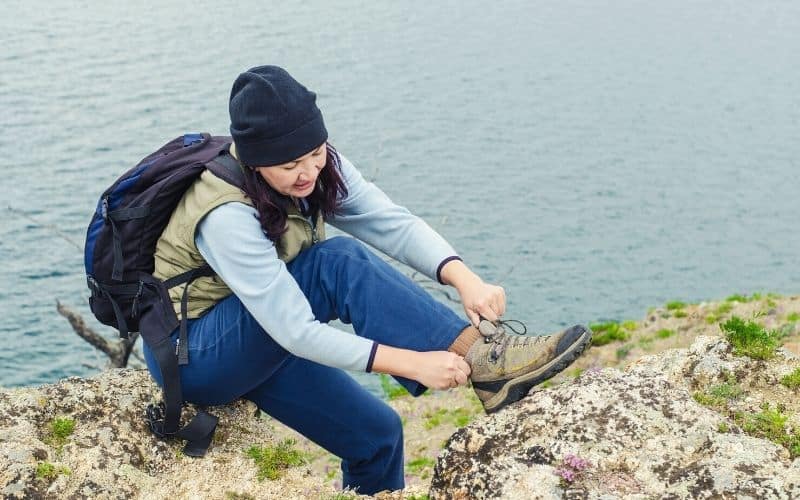
All About Bears
Although bears have a keen sense of smell, you don’t need to worry about attracting furry friends while menstruating. Research shows there is no evidence linking grizzly and black bear attacks to menstruation. Bears are no more attracted to the smell of period blood than other odors.
As with any odorous items, be sure to properly store your used menstrual products in a tightly sealed waste bag.
Hang all food and scented items in a dry bag high up in a tree away from your camp or store them in a smell-proof bear canister. Bears aren’t the only ones attracted to strong smells, animals like foxes and coyotes are also known for digging into campsite food and trash.
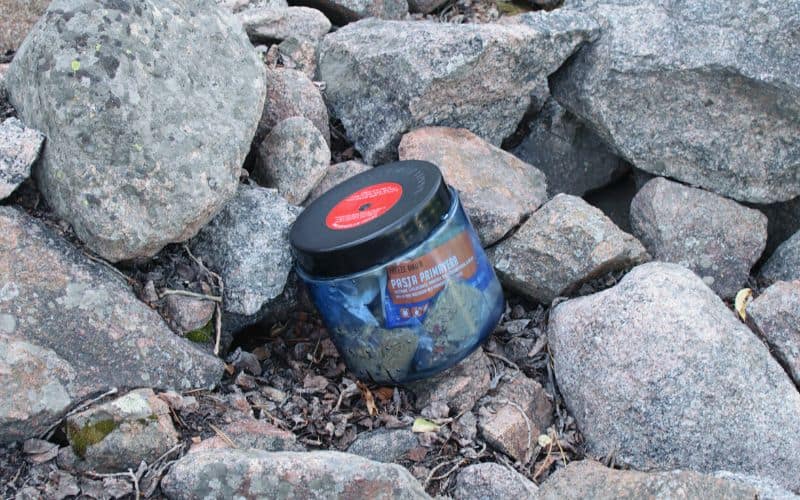
How to Deal With Cramps and Period Pain
Dealing with period cramps on your camping trips can be difficult, but there are ways to ease the pain.
Physical activity has been known to lessen menstrual pain for some by reducing uterine contractions. If you’re having mild cramps, try going for an easy hike to see if the pain subsides.
Applying heat to your lower abdomen may help alleviate cramps. Instead of packing a bulky heating pad, create a makeshift hot pad with a hot water bottle.
Heat water on your camp stove, fill a reusable water bottle with hot water, cover the bottle with a towel or piece of clothing to protect your skin from the heat and apply the hot water bottle to the area that hurts. You can also use instant hand warmers or adhesive heat wraps.
If you suffer from severe cramps, pack the pain relief medication you typically use at home. Don’t forget to pack enough for the entire trip.
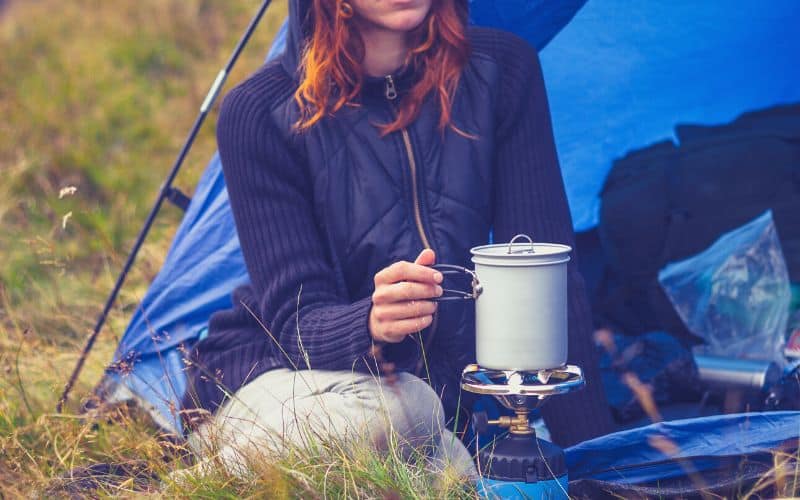
FAQs
Is it safe to go camping while on your period?
Yes, it is widely considered safe to go camping or hiking while menstruating. Being on your period shouldn’t stop you from pitching a tent and enjoying time in the great outdoors.
What to do when you have your period while camping?
Choose your preferred menstrual product, pack your kit, and head outdoors! Learning to deal with menstruating while camping takes a bit of practice, but don’t let it hold you back from your outdoor adventures.
Does having your period attract bears?
Camping while menstruating does not attract black bears or grizzly bears. You should always be cautious when in bear country, but there’s no need to be extra fearful if you’re menstruating. If you’re in an area with bears, use unscented products and store anything with a strong odor securely in a bear canister or hang it from a tree.
How do you dispose of tampons when camping?
To dispose of tampons properly when camping, use a disposable bag with a sealable top to store used tampons until you have access to a trash bin. Most tampons are not biodegradable. Do not bury tampons in the ground.
Happy Camping On Your Period!
We hope this information helps you feel comfortable enough to go camping or hiking while menstruating.
Pack your preferred period products, whether it’s a menstrual cup, tampons, or period panties, and put together a menstruation kit with wipes and a waste bag. Being prepared means not having to worry about backpacking, camping, or hiking during that time of the month.
What are your best tips for camping on your period? Let us know in the comments below. If you liked this article, please share it with your friends and family.
